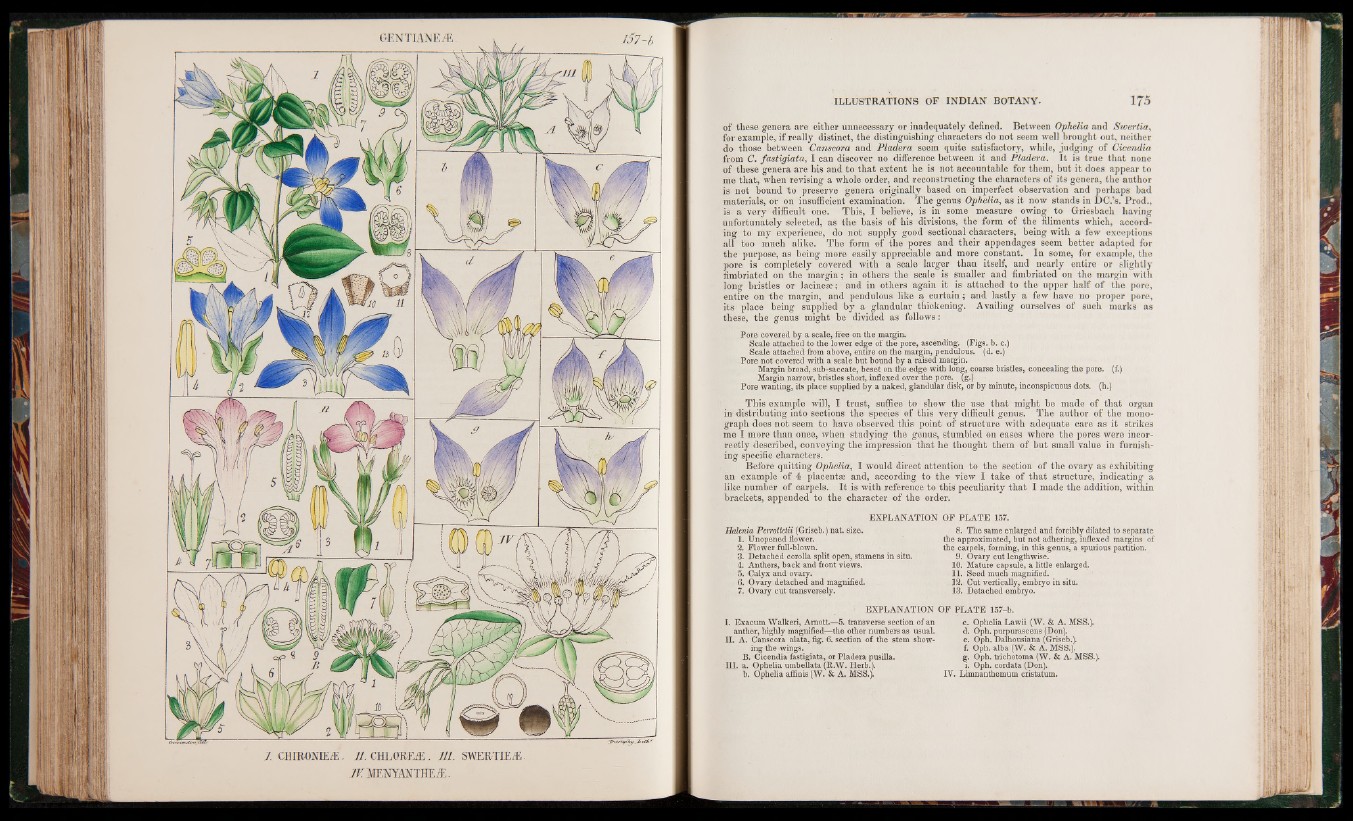
J. CHrRONIEÆ. IL CHLOKEÆ . RI. SWEPvTIEÆ.
JV. MENYANTHEÆ S
of these genera are either unnecessary or inadequately defined. Between Ophelia and Sivertia,
for example, if really distinct, the distinguishing characters do not seem well brought out, neither
do those between Canscora and Pladera seem quite satisfactory, while, judging of Cicendia
from C. fastigiata, I can discover no difference between it and Pladera. It is true that none
of these genera are his and to that extent he is not accountable for them, but it does appear to
me that, when revising a whole order, and reconstructing the characters of its genera, the author
is not bound to preserve genera originally based on imperfect observation and perhaps bad
materials, or on insufficient examination. The genus Ophelia, as it now stands in DC.’s. Prod.,
is a very difficult one. This, I believe, is in some measure owing to Griesbach having
unfortunately selected, as the basis of his divisions, the form of the Aliments which, according
to my experience, do not supply good sectional characters, being with a few exceptions
all too much alike. The form of the pores and their appendages seem better adapted for
the purpose, as being more easily appreciable and more constant. In some, for example, the
pore is completely covered with a scale larger than itself, and nearly entire or slightly
fimbriated on the margin; in others the scale is smaller and fimbriated on the margin with
long bristles or Jacinese; and in others again it is attached to the upper half of the pore,
entire on the margin, and pendulous like a curtain; and lastly a few have no proper pore,
its place being supplied by a glandular thickening. Availing ourselves of such marks as
these, the genus might be divided as follows:
Pore covered by a scale, free on the margin.
Scale attached to the lower edge of the pore, ascending. (Figs. b. c.)
Scale attached from above, entire on the margin, pendulous, (d. e.)
Pore not covered with a scale but bound by a raised margin.
Margin broad, sub-saccate, beset on the edge with long, coarse bristles, concealing the pore, (f.)
Margin narrow, bristles short, indexed over the pore, (g.)
Pore wanting, its place supplied by a naked, glandular disk, or by minute, inconspicuous dots, (h.)
This example will, I trust, suffice to show the use that might be made of that organ
in distributing into sections the species of this very difficult genus. The author of the monograph
does not seem to have observed this point of structure with adequate care as it strikes
me I more than once, when studying the genus, stumbled on cases where the pores were incorrectly
described, conveying the impression that he thought them of but small value in furnishing
specific characters.
Before quitting Ophelia, I would direct attention to the section of the ovary as exhibiting
an example of 4s placentas and, according to the view I take of that structure, indicating a
like number of carpels. It is with reference to this peculiarity that I made the addition, within
brackets, appended to the character of the order.
EXPLANATION OF PLATE 157.
Hcdenia Perrottetii (Griseb.) nat. size.
1. Unopened flower.
2. Flower full-blown.
3. Detached corolla split open, stamens in situ.
4. Anthers, back and front views.
5. Calyx and ovary.
6. Ovary detached and magnified.
7. Ovary cut transversely.
8. The same enlarged and forcibly dilated to separate
the approximated, but not adhering, indexed margins of
the carpels, forming, in this genus, a spurious partition.
9. Ovary cut lengthwise.
10. Mature capsule, a little enlarged.
11. Seed much magnified.
12. Cut vertically, embryo in situ.
13. Detached embryo.
EXPLANATION OF PLATE 157-b.
I. Exacum Walkeri, Arnott—5. transverse section of an
anther, highly magnified—the other numbers as usual.
II. A. Canscora alata, fig. 6. section of the stem showing
the wings.
B. Cicendia fastigiata, or Pladera pusilla.
III. a. Ophelia umbellata (R.W. Herb.),
b. Ophelia affinis (W. & A. MSS.).
c. Ophelia Lawii (W. & A. MSS.).
d. Oph. purpurascens (Don).
e. Oph. Dalhousiana (Griseb.).
f. Oph. alba (W. & A. MSS.).
g. Oph. trichotoma (W. & A. MSS.),
i. Oph. cordata (Don).
IV. Limnanthemum cristatum.